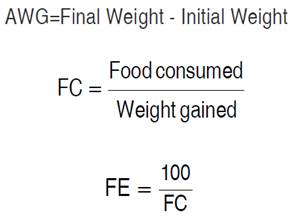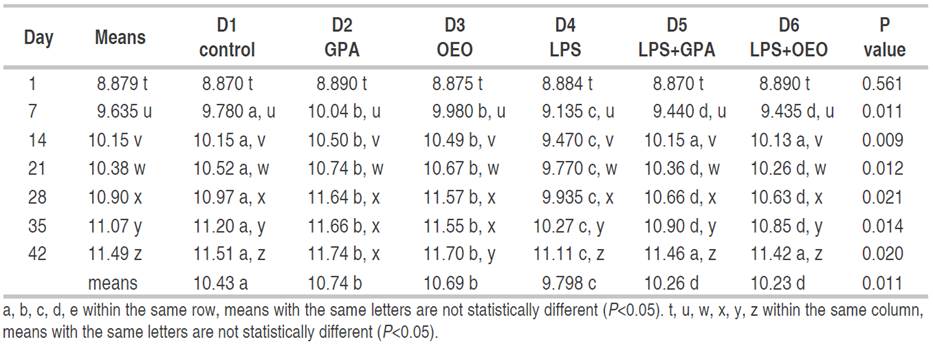Poultry meat production has grown substantially, doubling from the year 2000 to 2017, and achieving more open and competitive export markets worldwide. Additionally, more than 20% of world poultry production is in Latin America (Naciones Unidas, 2019). The growth of this production is due to the high demand for low-cost, high-quality animal protein, which, in turn, contributes to food security (FAO, 2018) and helps fight hunger of 795 million people around the world (98% live in developing countries) and malnutrition undergone by 12.9% of this population (FAO et al., 2018). For all the above mentioned, in Colombia, intensive poultry meat production has increased, becoming the most consumed meat in recent years (32.1 kg per person), exceeding bovine and pig origin product consumption (FENAVI, 2020).
The increase in the productive and economic performance rates of broilers under intensive conditions has triggered animal stress, increasing the deficiencies and imbalances in the composition of their intestinal microbiota. This has led to the appearance of frequent digestive disorders and the decrease in natural resistance to colonization by pathogenic microorganisms and their toxins (mainly lipopolysaccharide-LPS), causing chronic inflammatory processes at the intestinal level (Blajman et al., 2015).
Lipopolysaccharide is a bacterial endotoxin found predominantly on the outer membrane of gram-negative bacteria and is a potent stimulator of the immune response (Wellington et al., 2020). Therefore, the dietary addition of antimicrobial compounds is of great importance in the production process, mainly by reducing pathogenic bacterial populations and increasing productive parameters (Valenzuela-Grijalva et al., 2017). Nevertheless, given the increase in poultry meat production and consumption, there is a need for strict controls on the quality and safety of products that reach the final consumer.
The GPA use has become a public health concern due to the presence of traces in meat and the appearance of multi-resistant bacterial strains. It has led to the limited or prohibited non-therapeutic use (prophylactic and metaphylactic) of some antibiotics in different countries (García-Hernández and García-Curbelo, 2015). Additionally, additives must be recognized as GRAS (Generally Recognized As Safe) by the United States Food and Drug Administration (FDA) (Ciro et al., 2014). The essential oil of oregano (OEO) is extracted from the species Lippia origanoides belongs to the Verbenaceae family and has received the highest importance because it is an essential component of the Colombian biodiversity. In addition, it has the typical oregano chemotypes, that is, thymol predominates in its composition (between 67.2 and 78.7%), and there are low concentrations of carvacrol (between 0.9 and 1.2%) (Ortiz et al., 2017). Therefore, OEO is projected as a nutritional growth promoter with immunological benefits in broilers and GPA replacement (Madrid-Garcés et al., 2017).
Since most studies have evaluated different zootechnical, metabolic, and clinical parameters in broilers fed with OEO in optimal health conditions (Madrid-Garcés et al., 2018a), it is important to study the effect of this natural additive in intestinal inflammatory conditions induced by the administration of LPS of E. coli. This is one of the in vivo models most used in studies of acute infectious processes, as it has highly reproducible actions in different species and lacks the side effects associated with chronic bacterial infections (Ciro et al., 2014). Accordingly, this work aimed to evaluate the zootechnical parameters and blood metabolites of broilers fed with the addition of oregano essential oil (Lippia Origanoides) in an in vivo intestinal inflammation model (by adding LPS from E. coli).
MATERIALS AND METHODS
Ethical considerations. All the experimental procedures were carried out according to the guidelines proposed by "The International Guiding Principles for Biomedical Research Involving Animals" (Iclas, 2012; Leary et al., 2013). The Ethics Committee of Universidad Nacional de Colombia, Medellín campus endorsed this study through CEMED-013 of May 4, 2016.
Study site. The fieldwork was carried out at the San Pablo Agrarian Station that belongs to Universidad Nacional de Colombia, Medellín Campus, located in the municipality of Rionegro (Antioquia), in the zone called "El Tablacito" located at 2100 masl. The zone has a temperature between 12 and 18 °C, corresponding to a low montane very humid forest life zone (bmh-MB).
Animals. 1200 one-day-old male broilers of the ROSS308 genetic line from a commercial incubator were analyzed. These were housed in floor pens to recreate the density conditions of a commercial production, of which 420 were randomly selected (euthanized) for sampling in this experiment. Broilers rearing was carried out following commercial procedures employed on an experimental farm (Aviagen, 2017). The experimental period lasted 42 days.
Sanitary management. Before receiving the one-day-old broilers from a commercial incubator already vaccinated against Marek, Newcastle, and Gumboro diseases, the housing preparation procedures were developed as described below: washing, cleaning, and disinfection of the pens, curtains, feeders, and drinkers. Further, rodent and insect control was carried out with products obtained from commercial houses. The brooders were turned on 5 h before the arrival of the animals to preheat the pens up to a temperature of 32 °C for the moment when the animals were received (Aviagen, 2017).
Diets. A balanced commercial diet without the addition of antibiotics, essential oils, or LPS was used as a basal diet. In this basal diet, the growth-promoting antibiotic (GPA) Avilamycin, essential oil of oregano (OEO-Lippia Origanoides), and the endotoxin lipopolysaccharide (LPS) of E. coli as an in vivo intestinal inflammation model (Ciro et al., 2014) were added to the basal diet establishing the final diets (treatments), as follows:
Diet 1 (D1): Basal Diet (control) or balanced commercial diet without the addition of GPA, OEO, and LPS.
Diet 2 (D2): D1 with the addition of a GPA (Avilamycin, 150 ppm).
Diet 3 (D3): D1 with the addition of OEO (150 ppm).
Diet 4 (D4): D1 with the addition of 1.0 µg of LPS g-1 of food (1 ppm).
Diet 5 (D5): D1+1.0 µg of LPS g-1 of food (1 ppm) and a GPA (Avilamycin, 150 ppm).
Diet 6 (D6): D1 with the addition of 1.0 µg of LPS g-1 of feed (1 ppm) and OEO (150 ppm).
The basal diet was established for two growth stages and met the minimum nutritional requirements for the genetic line (Aviagen, 2017) (Table 1). The feed given during the first 21 days of the experiment was called "Start." For the following 22 days, the broilers were fed with the diet called "Finalization". The feed was free of antibiotics, except for diets D2 and D5, where Avilamycin was used as a GPA, as it is done commercially. OEO was added to the pre-mix at an effective concentration of 150 ppm and used as a phytobiotic for diets D3 and D6, according to Madrid-Garcés et al. (2018a) . The addition of 1.0 µg of LPS g-1 of feed (1 ppm) (LPS E. coli, serotype 0111: B4 Sigma-Aldrich, Sigma-Aldrich St Louis, MO, USA) was used in the study to generate the inflammation process in vivo (Ciro et al., 2014) in diets D4, D5, and D6.
Table 1 Nutritional contribution of the basal diet (BD), designed in two stages: start and finalization
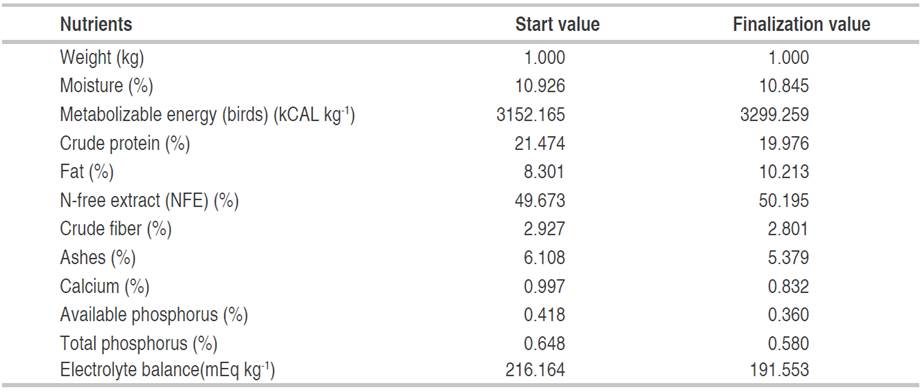
Animal performance parameters. Within the performance parameters evaluated, accumulated weight gain (AWG- Indicates how much weight an animal gains by sampling age), feed conversion (FC), and feed efficiency (FE) were selected, according to Li et al. (2019). The parameters were evaluated on days 21 and 42. AWG, FC, and FE were calculated by parameterization of the following equations:
Good euthanasia practices and sampling. All birds were sacrificed 2.5 h after their last meal. Animals were sedated by inhalations with Nitrox® and subsequently, euthanized humanely by inhalation with carbon dioxide for 3 min (Madrid-Garcés et al., 2018a). During the experimental phase, 420 animals were euthanized on days 1, 7, 14, 21, 28, 35, and 42, 60 animals per day (10 animals per treatment). A blood sample was taken from the aorta vein of each animal. For this analysis, 5 mL of blood per bird were taken on days 1, 21, and 42. Using a 25-mm needle, a cardiac puncture was performed, specifically in the left ventricle, for the extraction of blood in a test tube with an anticoagulant. Each of the samples was kept cold at 4 °C while being transported to the laboratory, where they were centrifuged at 1600 rpm for 10 min to separate the plasma into aliquots and then be analyzed (Maya-Ortega et al., 2021).
Quantification of blood metabolites. The metabolites evaluated were alanine aminotransferase, glucose, cholesterol, triglycerides, creatinine, calcium, and phosphorus. The quantification of the analytes in serum was carried out using the commercial slides VITROS® kits (Ortho Clinical Diagnostics, USA) specific for each analyte, following the manufacturer's instructions. A VITROS® DT-60II biochemical analyzer (Ortho Clinical Diagnostics, USA) was used to measure optical densities (Madrid-Garcés et al., 2018b).
Statistical analysis. For the analysis of the productive variables, a factorial model (6×2) was carried out, with six diets, two measurements days, and 10 replicates (each pen was an experimental unit). Each of the animals was randomly assigned to one of the six diets. The statistical analysis was performed according to the Proc Mixed procedure of the SAS® program version 14.3 software (SAS, 2017).
For the analysis of the different metabolites, a factorial model was performed, where the animals were randomized to one of the different diets (six), and each treatment (6 diets × 7 ages) had a total of 10 repetitions. The assumption of normality was analyzed using the Shapiro-Wilk test. The assumption of homoscedasticity was analyzed using the Bartlett test. And independence was guaranteed through good experimental practices. The multiple pair-wise comparisons were analyzed using a Tukey test (honestly significant difference-HSD) to establish the possible differences between groups. P-value significance was established at P<0.05.
RESULTS AND DISCUSSION
In general, the animals that consumed the different diets showed good health, without adverse symptoms or signs of disease that caused their withdrawal or euthanasia, or both, before the sampling periods. Additionally, the animals consumed the daily feed ration adjusted to the management guide for the Ross308 genetic line. In this experiment, no statistical interaction was found between different diets, evaluation days, and weaning age for any of the response variables in the study, so it was not necessary to analyze and disaggregate these factors independently.
Productive parameters
Accumulated weight gain (AWG). The accumulated weight gain (Table 2) did not show a statistically significant difference (P>0.05) at 21 days of age in the diets without the addition of LPS, obtaining D3 the numerically highest value in the different variables evaluated; furthermore, there was no difference (P>0.05) between the diets with the addition of LPS, where a reduction in productive performance was observed. When comparing the diets with LPS and those without the addition of LPS, the LPS-free diets presented better values (P<0.05). On day 42, a significant statistical difference was found between the diets, and D3 showed the best values (P<0.05). However, there were no differences (P>0.05) between D5 and D6. A statistically significant difference (P<0.05) was evidenced between day 21 (completion of the growing phase) and day 42 (completion of the fattening phase) for the AWG variable within each diet under study.
Table 2 Zootechnical parameters in broilers fed with the addition of oregano essential oil (Lippia origanoides) in an in vivo intestinal inflammation model.

Feed conversion (FC). Feed conversion on day 21 showed statistically significant differences (P<0.05) between D3 and the diets with LPS (D4, D5, and D6), but no statistically significant differences (P>0.05) were recorded with D1 and D2 (Table 2). Between D1 and D2, there was no difference (P>0.05), and further, between the diets with LPS, no difference was observed (P>0.05). By day 42, a significant statistical difference was found between the diets without LPS, and D3 obtained the best results. Nevertheless, there was no difference between D3 and D2, and between the latter and D1 (P>0.05). There was no difference (P>0.05) between the diets with the addition of LPS (D4, D5, and D6). Nonetheless, these diets did not show differences with D1 (P>0.05) (Table 2). A statistically significant difference (P<0.05) was evidenced between day 21 (completion of the growing stage) and day 42 (completion of the fattening stage) for FC within each of the studied diets, finding differences in productive performance in the two stages.
Feed efficiency (FE). FE for day 21 obtained a significant statistical difference (P <0.05) between D3 and the other diets, except for D2, which also presented statistical differences (P<0.05) with D4, D5, and D6. However, these last diets did not show differences with D1 (P>0.05). On day 42, there was no significant statistical difference (P>0.05) between D2 and D3, and neither between D5, and D6. Nonetheless, a statistical difference (P<0.05) was found between D1 and the other diets. Further, a statistically significant difference (P<0.05) was evidenced between day 21 (completion of the growing stage) and day 42 (completion of the fattening stage) for FE within each diet under study. With the data obtained in this work, most results showed a positive effect on the zootechnical parameters when using GPA (D2) and OEO (D3), when compared with the basal diet (D1). These results corroborate what was found in other studies that compared different levels of OEO inclusion with a basal diet and another diet with Zinc Bacitracin as a GPA (Madrid-Garcés et al., 2017). The addition of LPS (D4) harmed the zootechnical parameters when compared with those obtained with the basal diet (D1) and with the diets that had GPA and OEO; however, in the diets that were given together with LPS+ GPA (D5) and LPS+OEO (D6), there was an improvement in the values, without reaching the values found with the basal diets (D1, D2, and D3). The values found on day 21 are similar to those reported by Trómpiz et al. (2011); these authors evaluated different diets on the fattening parameters of female chicks in their raising phase.
Concerning feed conversion (FC), average results similar to those found by Lázaro et al. (2017) were obtained on day 21, but very dissimilar from day 42. A study by Miranda-López et al. (2007) reported mean values for day 21 similar to those of this study. Karimzadeh et al. (2017) reported values between 1.61 and 1.77 for the FC indicator, values very similar to those found in the present study. Furthermore, they reported AWG (kg) values between 2.186 and 2.419 on day 42, very different from the results obtained in the current study (between 2.668 for D4 and 2.910 for D3). Another study reported FC values between 1.583 and 1.655 (Broch et al., 2017).
Blood metabolites
Alanine aminotransferase (ALT). ALT obtained average values per day of age from 3.13 to 43.1 (U L-1), presenting the highest values on day 21 of age (P<0.05). In the average values per diet, significant statistical differences were found for D2 with the other diets (P<0.05), except for D3 and D1(Table 3). Differences were found between D4 with D5 and D6, but no differences were found between the last two (P>0.05). Moreover, no statistically significant difference (P>0.05) was observed between D1 with D2 and D3. ALT results provide specific information about liver problems in an organism. In animals with fatty liver, ALT levels are usually higher (Alegría et al., 2015). Other studies in broilers have reported values between 17.1 and 21.6 mg dL-1 (Bueno et al., 2017), and between 10.84 and 17.28 mg dL-1 (Broch et al., 2017). The addition of GPA (D2) and OEO (D3) was shown to positively affect the ALT concentration in serum, reporting better values from the liver health standpoint. LPS had a negative effect on the ALT concentration, where the addition of GPA (D5) and OEO (D6) was done, having a mitigating effect on the damage generated by the addition of LPS. The negative effect of LPS may be explained by the metabolic demand of the body to generate an inflammatory response in the presence of a molecular pattern associated with a pathogen in the intestine.
Table 3 Alanine transferase (ALT, U L-1) in blood serum of broilers fed with the addition of oregano essential oil (Lippia origanoides) in an in vivo intestinal inflammation model.

Glucose. The average glucose values by age ranged from 266.6 mg dL-1 (day 7) to 316.3 mg dL-1 (day 42), where no differences were observed between the values of days 1 and 7 (P<0.05). The mean glucose values per diet ranged from 269 mg dL-1 (D4) to 300.4 mg dL-1 (D2) for the different diets (P<0.05). Significant statistical differences were found in the averages of the different diets, except between D2 and D3, which presented the highest values (Table 4). Glucose is one of the most critical blood metabolites as it is the basic metabolic fuel during the normal nutrition period of monogastric animals, and in turn, it is essential for the maintenance and continuous contribution to animal metabolism. Increases in glucose levels in fattening animals are related to increases in energy metabolism (Cunninghan, 2013). The data reported in this work differ from those found by Lázaro et al. (2017), being those of the current study substantially higher for all ages. The reason could be associated with the fact that the diet of the study mentioned above had lower metabolizable energy in the various stages. In a previous study by Madrid-Garcés et al. (2017), similar but lower values were reported explaining these results by the lower energy levels used in a multistage diet. Another study that evaluated the effect of age and cyclical heat stress on the biochemical profile of broiler serum reported values between 248.4 and 282.7 mg dL-1 (Bueno et al., 2017), and between 199.76 and 217.20 mg dL-1 (Broch et al., 2017). In general, the data were consistent, and the negative effect of LPS on this variable was evidenced due to the imbalance in homeostasis attributed to the induced inflammatory process. However, a positive effect was observed in the addition of GPA or OEO in the presence of LPS as an in vivo inflammation model. At 21 and 28 days of age, the best behavior was found in the diets with the addition of GPA and OEO. Both GPA and OEO showed a positive effect on intestinal inflammation.
Table 4 Glucose (mg dL-1) in blood serum of broilers fed with the addition of oregano essential oil (Lippia origanoides) in an in vivo intestinal inflammation model.
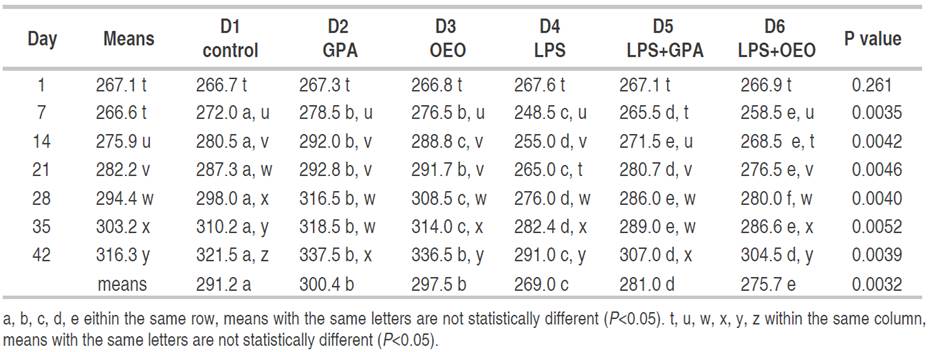
Cholesterol. For the variable blood cholesterol, mean values were found for the different ages from 131.8 mg dL-1 (Day 1) to 193.1 mg dL-1 (Day 21), with statistically significant differences between all the ages assessed (P<0.05). Day 21 presented the highest values in each of the diets evaluated. For the different diets, values from 150.8 mg dL-1 (D2) to 167.2 mg dL-1 (D4) were found with statistically significant differences between all diets, except between D5 and D6, which D4 recorded the highest values (Table 5). Lázaro et al. (2017) found cholesterol values between 105 and 121 mg dL-1, that is, lower than those reported in the current study. Regarding glucose, the differences may be associated with the use of various commercial diagnostic kits. Karimzadeh et al. (2017) reported values between 105 and 140 mg dL-1. Bueno et al. (2017) observed values between 102.9 and 154.8 mg dL-1, and Broch et al. (2017) found values between 104.32 and 117.20 mg dL-1. Diets with the addition of LPS (inflammation model) were shown to have a negative effect, increasing blood cholesterol levels; nevertheless, the addition of GPA and OEO showed a positive effect on the inflammation model, without finding a statistically significant difference between the two treatments (D5 and D6).
Table 5 Cholesterol (mg dL-1) in blood serum of broilers fed with the addition of oregano essential oil (Lippia origanoides) in an in vivo intestinal inflammation model.
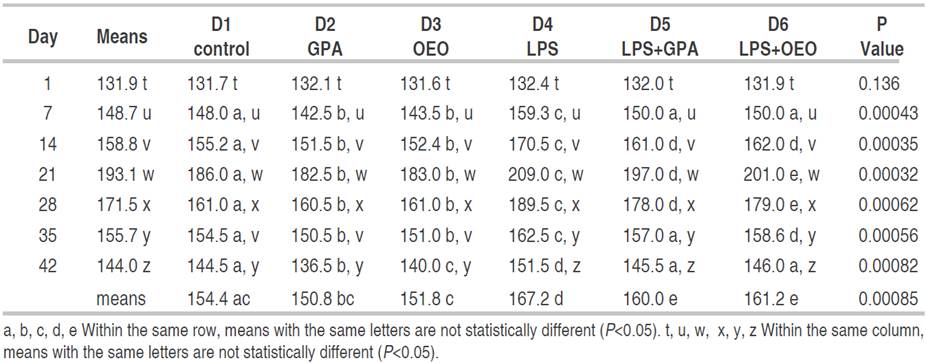
Triglycerides. For triglycerides, mean values were found for the different ages from 128.1 mg dL-1 (Day 1) to 203.1 mg dL-1 (Day 21), observing a statistically significant difference between all the days (ages) evaluated (P< 0.05). For the average values of triglycerides in the different diets, values from 156.7 mg dL-1 (D2) to 186.4 mg dL-1 (D4) were found, and statistical differences between all diets (P<0.05), except between D2 and D3 (lowest values), and between D5 and D6 (P>0.05) were recorded (Table 6). Lázaro et al. (2017) found values between 85 and 97 mg dL-1, which are relatively lower than those found in the current study. Meanwhile, Karimzadeh et al. (2017) reported values between 22.3 and 46.9 mg dL-1 and Bueno et al. (2017) between 30 and 33.7 mg dL-1. The difference in values may be associated with the energy in the diet and the ingredients used for either extract component. The addition of LPS showed to have an effect of increasing blood triglycerides, while the diets with GPA and OEO had a positive effect since they reduced the concentration of triglycerides in the blood when compared to the basal diet, an effect that is also reflected in the diets that only had LPS and those that had LPS+GPA. GPA and OEO positively influenced intestinal inflammation; however, they did not present statistically significant differences between them (D5 and D6).
Table 6 Triglycerides (mg dL-1) in blood serum of broilers fed with the addition of oregano essential oil (Lippia origanoides) in an in vivo intestinal inflammation model.
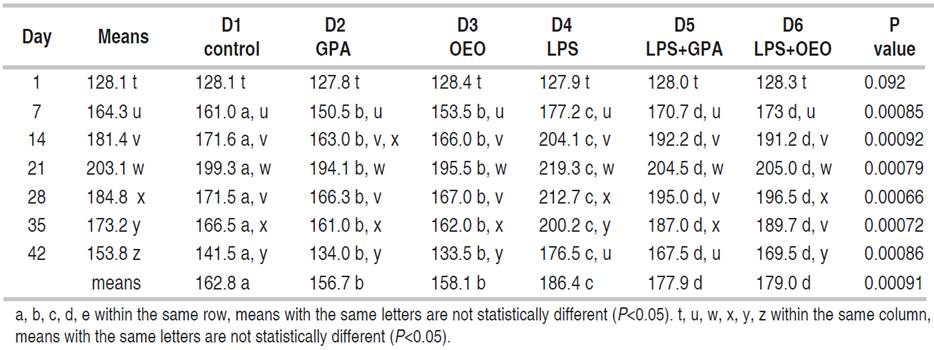
Creatinine. Mean creatinine values ranging from 0.235 mg dL-1 (day 1) to 0.373 mg dL-1 (day 21) had a statistically significant difference between all ages (P<0.05), except between day 7 and day 42 (P>0.05). In the different diets, averages from 0.278 mg dL-1 (D2) and 0.355 mg dL-1 (D4) were found. There was no statistically significant difference (P>0.05) between D2 and D3 (lowest values), but there was a significant difference (P<0.05) between D1 and D4 (Table 7). Besides, no significant statistical differences were found between D1, D5, and D6 (P>0.05). Creatinine is produced endogenously from creatine and creatine phosphate as a result of muscular metabolic processes and it is eliminated through the kidney by glomerular filtration. The determination of serum creatinine is useful for the diagnosis and control of acute and chronic kidney diseases, and the estimation of glomerular filtration (Perazzi and Angerosa, 2011). Some studies have reported creatinine values between 0.44 and 1.24 mg dL-1 (Bueno et al., 2017), and others between 0.17 and 0.20 mg dL-1 (Broch et al., 2017). OEO affected the serum creatinine reduction in comparison with that of GPA. The use of LPS in an in vivo intestinal inflammation model showed to affect the serum creatinine, increasing its levels. The use of GPA and OEO significantly mitigated the creatinine rise generated by LPS.
Table 7 Creatinine (mg dL-1) in blood serum of broilers fed with the addition of oregano essential oil (Lippia origanoides) in an in vivo intestinal inflammation model.
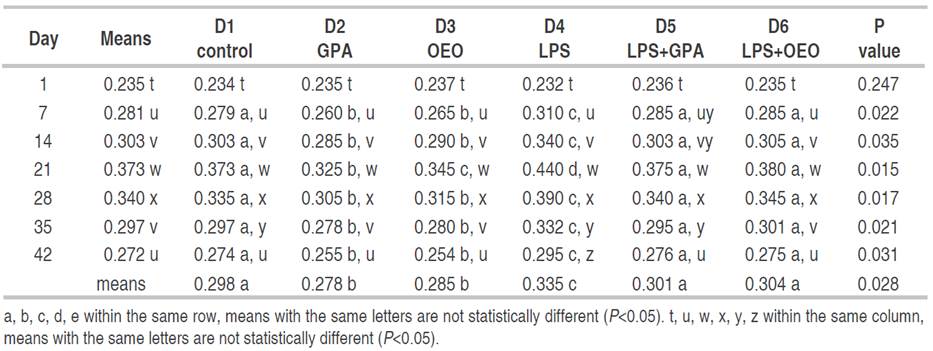
Phosphorous (P). For the variable phosphorus, average values from 7.100 mg dL-1 (Day 1) to 9.022 mg dL-1 (Day 42) were found with a statistically significant difference between the different evaluation ages (P<0.05). In the different diets evaluated, average values from 7.304 mg dL-1 (D4) to 8.662 mg dL-1 (D2) were registered with statistically significant differences (P<0.05) between all treatments (P>0.05), except for D2 and D3 (highest values) (Table 8). P is one of the macrominerals with the highest concentration in organisms; it is considered an essential mineral for the metabolism of the animal organism, playing a vital role in the development and maintenance of bone structures, an aspect of great importance in poultry farming. When animals have highly accelerated muscle development, bone development must be consistent with it. P is also a component of ATP and nucleic acids and is part of the phospholipids that comprise and give flexibility to cell membranes (Díaz-González et al., 2012). Some studies have reported values between 2.5 and 3.1 mg dL-1 (Karimzadeh et al., 2017), and 6.50 and 7.63 mg dL-1 (Díaz-López et al., 2014). The results of these studies show an increase in blood P levels in animals fed the diets containing growth promoters; conversely, a reduction of P was also evidenced in animals subjected to LPS and an evident improvement in this response with the addition of the two promoters (GPA and OEO).
Table 8 Phosphorus (mg dL-1) in blood serum of broilers fed with the addition of oregano essential oil (Lippia origanoides) in an in vivo intestinal inflammation model.
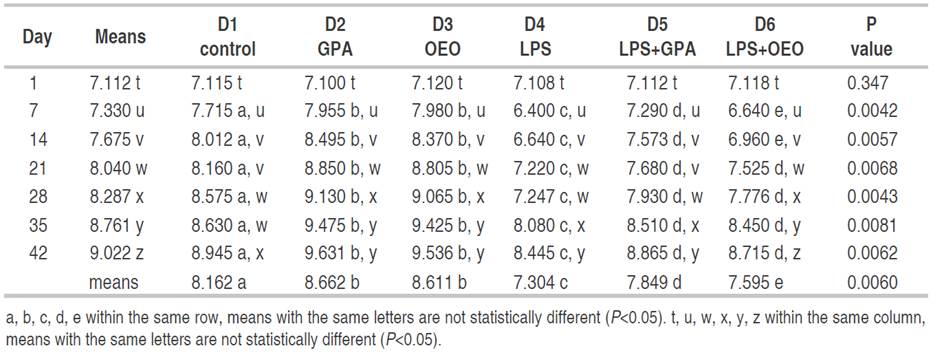
Calcium. Mean blood calcium values ranged from 8.89 mg dL-1 (Day 1) to 11.49 mg dL-1 (Day 42), with statistically significant differences for all evaluation ages (P<0.05). The diets 9.798 mg dL-1 (D4) and 10.74 mg dL-1 (D2) had a statistically significant difference between all diets (P<0.05), except (P>0.05) between D2 and D3, and between D5 and D6 (Table 9). Calcium is one of the macrominerals that are in the highest concentration in the animal organism; it is vital for the maintenance of muscle function and bone structure, and necessary for intestinal microorganism functions. The calcium concentrations reported in the current study are similar to other investigations reporting values between 9.72 and 11.10 mg dL-1 (Díaz-González et al., 2012; Karimzadeh et al., 2017). The results show the positive effect that growth promoters (D2 and D3) have when compared to the basal diet (D1). The effect of reducing blood calcium in animals that consumed the diet with LPS is also evidenced, in addition to the positive recovery effect against the LPS exposure/challenge shown by those that consumed GPA (D5) and OEO (D6).
CONCLUSIONS
The addition of GPA in the diet had a positive effect when compared to the basal diet. Moreover, the addition of OEO in the diet improved productive and metabolic indicators, equaling, and in some cases, exceeding the results obtained using GPA. The addition of LPS as an in vivo inflammation model had a negative effect on productive and metabolic variables. On the contrary, the addition of OEO showed a positive effect on zootechnical parameters and blood metabolites of broilers subjected to an in vivo intestinal inflammation model with the addition of E. coli LPS. Therefore, OEO could be considered to partially or totally replace the use of GPA.














